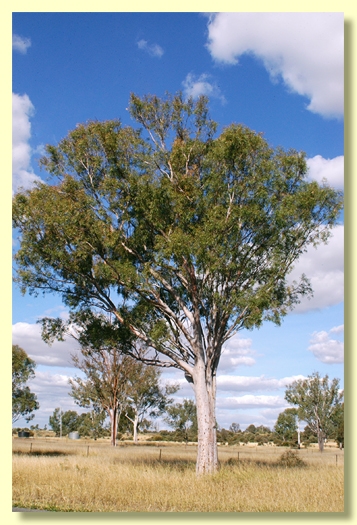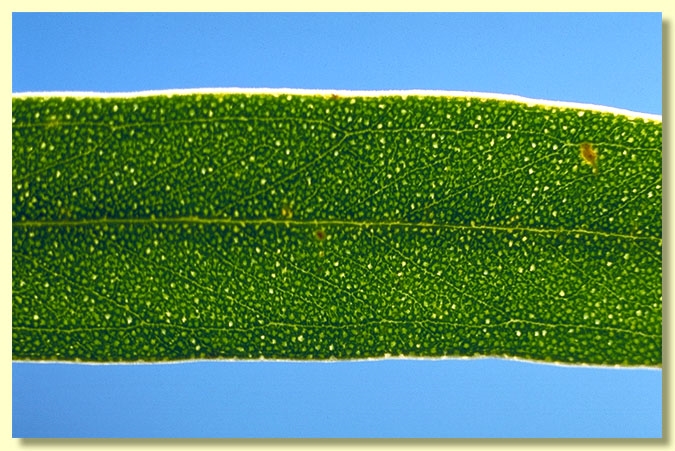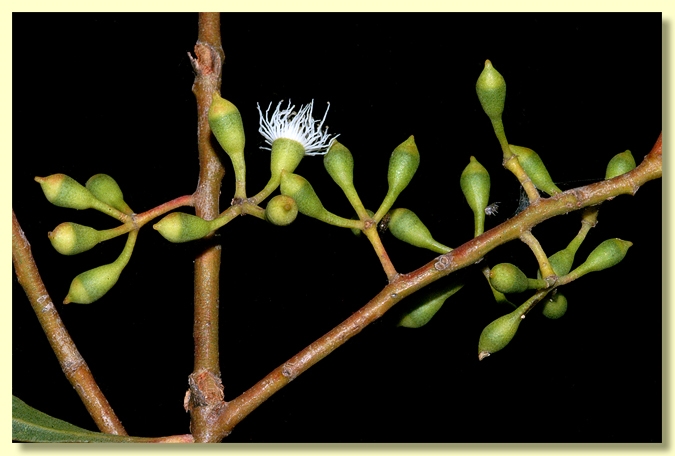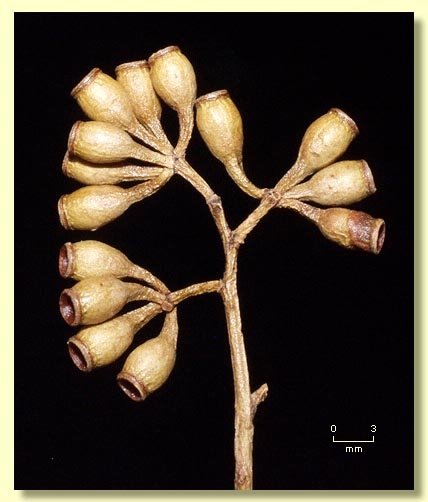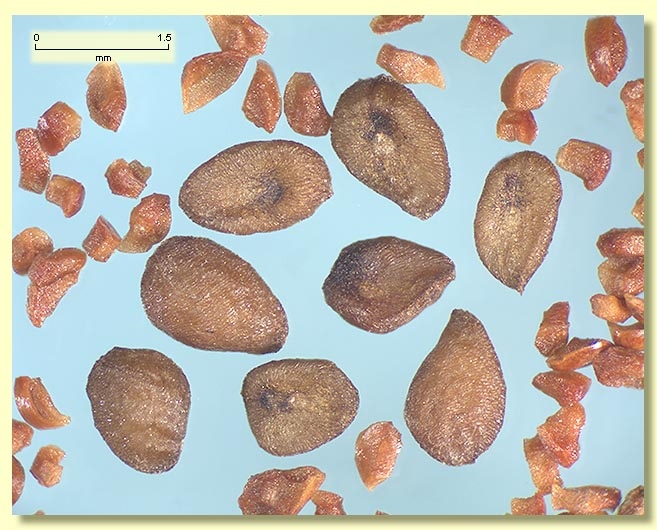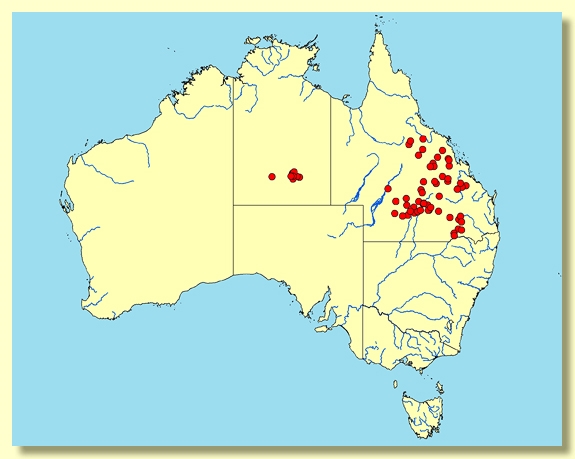Eucalyptus | Symphyomyrtus | Adnataria | Apicales | Coalitae
Euclid - Online edition
Eucalyptus thozetiana
Eucalyptus thozetiana (Maiden) R.T.Baker, Proc. Linn. Soc. New South Wales 31: 305 (1906).
Eucalyptus calycogona var. thozetiana Maiden, Critical Revision Eucalyptus 1: 87 (1903). T: Expedition Range, Queensland, 1878, A.Thozet s.n.; Lectotype: MEL; isolectotype NSW (fide A.R. Bean Telopea 12: 475 (2010)).
Eucalyptus gracilis var. thozetiana Bailey, Queensland Fl. 2: 615 (1900). T: Expedition ranges, Queensland, Bowman & O’Shanesy s.n.; nomen nudum (fide Bean loc. cit .)
Tree to 17 m tall, trunk fluted. Forming a lignotuber.
Bark smooth throughout or less commonly with a short stocking of tessellated blackish rough bark. Smooth bark pinkish to creamy white with greyish patches. Small curls or flakes of imperfectly shed bark may be present at times on the otherwise smooth stems.
Branchlets lack oil glands in the pith; non-glaucous.
Juvenile growth (coppice or field seedlings to 50 cm): stems square in cross-section; juvenile leaves always shortly petiolate, opposite for up to ca 6 nodes then alternate, linear, 3.5–16 cm long, 0.3–0.5 cm wide, green.
Adult leaves alternate, petioles 0.2–1.5 cm long; blade linear to narrowly elliptical or lanceolate, occasionally falcate, 5–14 cm long, 0.5–1.5(2) cm wide, base tapering to petiole, margin entire, apex pointed, concolorous, glossy, green, side-veins usually acute, reticulation sparse to moderate and incomplete, intramarginal vein remote from margin, oil glands irregular in shape, mostly island.
Inflorescence terminal compound or sometimes axillary single, or axillary compound below this; peduncles slender, angular, 0.2–1.5 cm long, buds 7(9 or 11) per umbel, pedicels 0.2–0.5 cm long. Mature buds pyriform to obovoid, slightly angular at the base, 0.4–0.6 cm long, 0.2–0.4 cm wide, scar absent (both opercula shed together at flowering), operculum rounded to conical or beaked, stamens inflexed, outer lacking anthers (staminodes), anthers weakly adnate, basifixed, cuboid to globoid, dehiscing by short sub-terminal slits, style long and straight, stigma blunt to tapering, locules 3 or 4, the placentae each with 4 vertical ovule rows. Flowers white.
Fruit on pedicels 0.2–0.7 cm long, narrowly urn-shaped to barrel-shaped or cylindrical, 0.3–0.5 cm long, (0.2)0.3–0.4(0.5) cm wide, disc descending vertically, valves 3 or 4, enclosed.
Seeds brown, 1–2 mm long, flattened-ovoid, dorsal surface shallowly reticulate, hilum ventral.
Cultivated seedlings (measured at ca node 10): cotyledons reniform; stems square in cross-section; leaves always petiolate, opposite for 7–9 nodes then becoming alternate, linear, 3.5–9 cm long, 0.3–0.4 cm wide, dull, green.
Flowering has been recorded in March, April, May, June, July, August, September, October and November.
A slender tree widespread in Queensland from Jundah and Quilpie in the south-west, east to the Darling Downs and north to near Emerald. The species also occurs disjunctly in the south of the Northern Territory near Arltunga and sporadically in the Macdonnell Ranges. It prefers pebbly soils on slight rises. Eucalyptus thozetiana has a conspicuous glossy green crown, compound inflorescences, slender more or less urceolate fruit and, over much of its range, smooth bark, only developing an extensive rough stocking in the south of the species range.
Eucalyptus thozetiana belongs in Eucalyptus subgenus Symphyomyrtus section Adnataria (the boxes) because the buds have two opercula, ovules are in four rows, seeds are flattened-ovoid, cotyledons are reniform, and anthers are rigid on the staminal filaments. Within section Adnataria, E. thozetiana, together with E. ochrophloia, forms series Coalitae, further distinguished by having buds with the outer and inner opercula united and shed at flowering time, outer stamens sterile (staminodes) and obscure or sparse leaf venation.
Eucalyptus thozetiana has smaller buds and fruit than E. ochrophloia, a species preferring the heavier soils along seasonal drainage channels in south-western Queensland and north-western New South Wales. Plants in the Eulo, Nokatunga and Moble area of south-western Queensland appear to be intermediate between these two species, having buds and fruit too small to be E. ochrophloia and too large for E. thozetiana and with short pedicels.
Eucalyptus thozetiana: after Anthelme Thozet (1826–1878). Anthelme Thozet was a French-Australian botanist who migrated to Australia some time before 1856 and lived in Sydney where he worked as a gardener at the Royal Botanic Gardens, Sydney (1856-1858). He then moved to Rockhampton for the Canoona gold rush. He was an energetic plant collector, especially in the area within c. 150 km of Rockhampton; most of his specimens went to F. Mueller in Melbourne, but he was also active in making Australian plants known in France. He also cultivated many economic plants and prepared them for commercial use. His private garden was an experimental area of great value, in which he introduced many plants to central Queensland, and to the rest of the State. In addition to supplying material to F. Mueller, he also provided the Australian Museum with wood specimens from the Rockhampton area. He became the first Director of the Rockhampton Botanic Gardens founded in 1861. After resignation from that position he established his own plant nursery.

